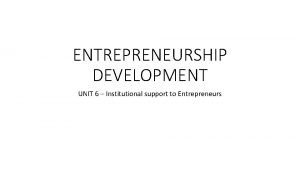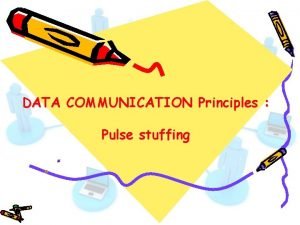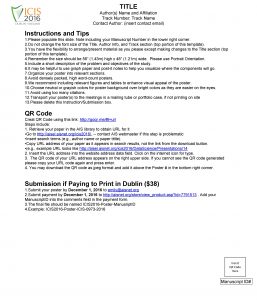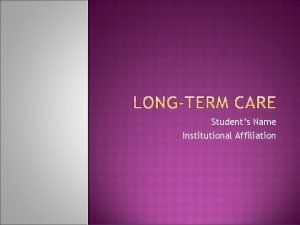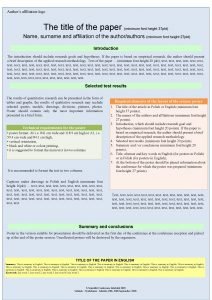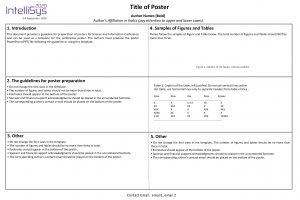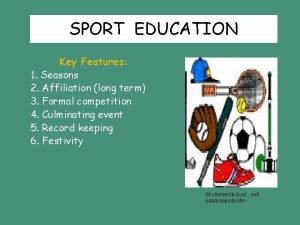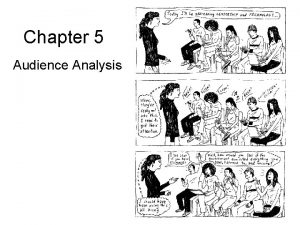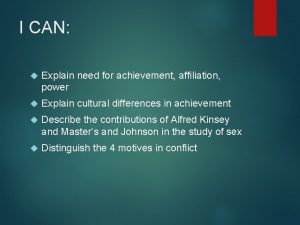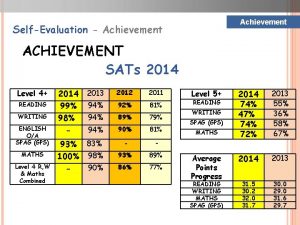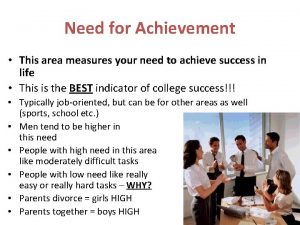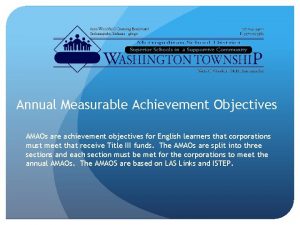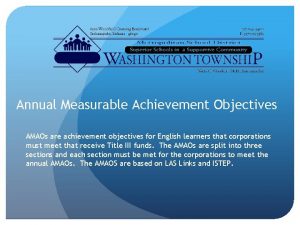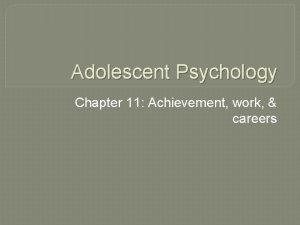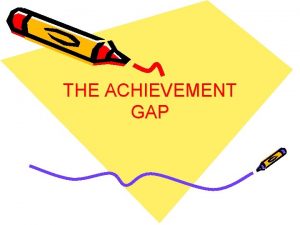I CAN Explain need for achievement affiliation power


























- Slides: 26

I CAN: • Explain need for achievement, affiliation, power • Explain cultural differences in achievement • Explain weight trends and cultural influences involving hunger/weight • Describe the contributions of Alfred Kinsey and Master’s and Johnson in the study of sex • Distinguish the 4 motives in conflict

How Are Achievement, Hunger, and Sex Alike? Different? No single theory accounts for all forms of motivation, because each motive involves its own mix of biological, mental, behavioral, and social/cultural influences Copyright © Allyn & Bacon 2007

Need for Achievement (n Ach) • Mental state that produces a psychological motive to excel or reach some goal The desire to attain a difficult, but desired, goal Copyright © Allyn & Bacon 2007

Three Types of Needs • Need for Achievement (n. Ach) • Need for Affiliation (n. Aff) • the need for friendly social interactions and relationships with others. • Need for Power (n. Pow) • the need to have control influence over others. or Copyright © Allyn & Bacon 2007

A Cross-Cultural Perspective on Achievement • Individualism • Collectivism View that places a high value on individual achievement and distinction View that values group loyalty and pride over individual distinction • Common in Asia, Africa, Latin America, Middle East • Common in the Western world…Europe, the U. S. Copyright © Allyn & Bacon 2007

Hunger as Motivation • Eating comes naturally • If it was entirely learned, would probably die learning it Copyright © Allyn & Bacon 2007 you starve before

The Multiple-Systems Approach to hunger – Hunger Your combines many facts: Example: readiness to eat a piece --the body’s energy of–pizza depends on…requirements – --food (Sweet/high fat foods) when you preferences last ate whether you like pizza – --environmental food cues the time of day – --cultural demands are your friends encouraging you to have a – --social norms piece body biology is –it--basic culturally acceptable are you dieting Copyright © Allyn & Bacon 2007

Set Point – Refers to the tendency of the body to maintain a certain level of body fat and body weight Copyright © Allyn & Bacon 2007

Motivation and Hunger § The hypothalamus controls eating and other body maintenance functions Copyright © Allyn & Bacon 2007

Eating Disorders • Bulimia Nervosa • Binge eating followed by purging • Anorexia Nervosa • Inappropriate eating habits • Irrational fear of weight gain • Distorted body perception Copyright © Allyn & Bacon 2007

Women’s Body Images 1 – 5 Scale Copyright © Allyn & Bacon 2007

• The Thinning of Miss America Trend in Body Mass Index (BMI) of Miss America Pageant Winners 24 BMI, kg/m² 23 22 • 21 • 20 19 18 17 16 15 • Trend line • • • • • • • • • • • • World Health • Organization’s • cutoff point for undernutrition (18. 5) • • 1920 1930 1940 1950 1960 1970 1980 1990 2000 Year of Pageant Copyright © Allyn & Bacon 2007

The Thirst Drive • Volumetric Thirst • A drop in extracellular fluid levels • (Fluid outside the cells, such as in the blood) Copyright © Allyn & Bacon 2007

The Thirst Drive • Osmotic Thirst • A drop in intracellular fluid levels • Results from water moving through the cell walls…escaping in the form of sweat, urine, feces, mucus, breath moisture Copyright © Allyn & Bacon 2007

Pain • Usually produces a drive to avoid or remove, rather than seek, a stimulus.

Sex and Motivation • Sex in NOT a homeostatic drive because it does not return the body to a state of equilibrium • The brain is the major sex organ in humans

The Scientific Study of Sexuality • 1. Alfred Kinsey: Beginning in 1948, interviewed 17, 000 Americans concerning their sexual behavior. • Finding: Certain sexual behaviors thought to be rare were, in fact, common • 2. Masters and Johnson 1960 s-70 s • Brought sex into the laboratory – Sexual Response Cycle – Four-stage sequence of arousal, plateau, orgasm, and resolution occurring in both men and women

Sexual Motivation Same drives, different attitudes Copyright © Allyn & Bacon 2007

Sexual Scripts • Socially learned ways of responding in sexual situations • Both learning and genetics affect our sexual behaviors

Motives in Conflict • Approach-Approach Conflict • A conflict in which one must choose between two equally attractive options • Finishing college and a full-time job offer • Easiest conflict to resolve Copyright © Allyn & Bacon 2007

Motives in Conflict • Approach-Avoidance Conflict • A conflict in which there are both appealing and negative aspects to the decision to be made • Going out to a party, knowing that you will be grounded for being at the party. Copyright © Allyn & Bacon 2007

Motives in Conflict • Avoidance-Avoidance Conflict • A conflict in which one must choose between two equally unattractive options • You intensely hate your job, but fear the reality of unemployment if you quit Copyright © Allyn & Bacon 2007

Motives in Conflict • Multiple Approach-Avoidance Conflict • A conflict in which one must choose between options that have both many attractive and many negative aspects Go to the Party Meet friends Have a good time Aren’t alone Aren’t bored Go to the Party Get grounded Don’t study for a test …fail it Do something stupid that you’ll regret Copyright © Allyn & Bacon 2007

The Origins of Sexual Orientation • Heterosexuality • Homosexuality • Several theories about orientation…testosterone levels and parenting do not contribute Copyright © Allyn & Bacon 2007

The Origins of Sexual Orientation Copyright © Allyn & Bacon 2007

CAN I? • Explain need for achievement, affiliation, power • Explain cultural differences in achievement • Explain weight trends and cultural influences involving hunger/weight • Describe the contributions of Alfred Kinsey and Master’s and Johnson in the study of sex • Distinguish the 4 motives in conflict
 Contoh tes performansi tipikal
Contoh tes performansi tipikal Apa itu need for achievement
Apa itu need for achievement Power traiangle
Power traiangle Accountancy for lawyers meaning
Accountancy for lawyers meaning Institutional services to entrepreneurs
Institutional services to entrepreneurs Need of pulse stuffing in tdm
Need of pulse stuffing in tdm Signal words for fact and opinion
Signal words for fact and opinion Affiliation poster
Affiliation poster Affiliation author
Affiliation author Name and affiliation
Name and affiliation Title and affiliation
Title and affiliation Vignette mutualité chrétienne
Vignette mutualité chrétienne Numero niss
Numero niss Institutional affiliation definition
Institutional affiliation definition Pre-affiliation stage
Pre-affiliation stage Anita woolfolk hoy
Anita woolfolk hoy Paper author affiliation
Paper author affiliation Affiliation poster
Affiliation poster Dept. name of organization
Dept. name of organization Title author
Title author Sport affiliation
Sport affiliation Gang dress code
Gang dress code Situational audience analysis
Situational audience analysis Title and initials
Title and initials Ovale2 affiliation
Ovale2 affiliation Dept. name of organization
Dept. name of organization Predominant church affiliation by county 2000 frq
Predominant church affiliation by county 2000 frq




